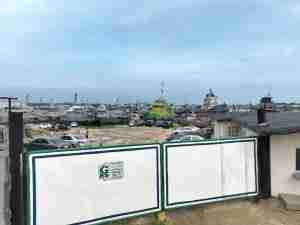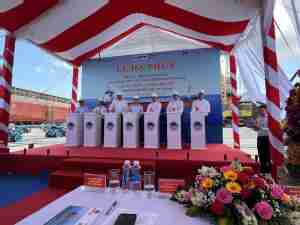In most years, cargo volumes drop sharply after the last of the Christmas shipments at the end of October. However, November 2004 was Long Beach's busiest month ever and December and January have been nearly as busy.
Signaling perhaps more year-around shipments from Asia, imports jumped 25.4% to 252,785 twenty-foot equivalent units. Exports climbed 11.8% to a modest 81,580 teus. As evidence of the big trade deficit, the number of empty containers ' nearly all headed overseas ' increased 71.2% to 175,232 teus.
S&P raises port credit rating
Standard & Poor's Rating Services has raised the Port of long Beach's credit rating to "AA" from "AA-minus," citing "impressive historic and forecast cargo growth along with a very strong business and financial position."
Two other leading bond rating firms -- Fitch Ratings and Moody's ' also awarded some of their highest ratings to the Port in connection with the issuance of two revenue bonds: the Port's $233 million series 2005A and $25 million series 2005B.
The proceeds will be used to pay off a series of harbor revenue bonds issued in 1995 at a higher interest rate. Fitch assigned its 'AA' rating to the two new revenue bonds; and Moody's assigned an Aa3 rating. Both Standard & Poor's and Fitch affirmed a "stable" outlook for the Port's $1.1 billion in outstanding debt.
S&P said its stable outlook reflects the "expectation that financial and operational trends will remain very strong at the Port."
Moody's assigns port Aa3 rating
The Moody's rating firm said it assigned its Aa3 rating and upgraded its outlook to "positive" from stable because of the Port's " healthy financial margins, high levels of liquidity, and both a sizeable local market and key intermodal connections for transport across the United States."
Moody's added that its positive outlook "reflects the port's ability to not only maintain healthy financial margins despite the loss of its largest tenant in 2002."
Maersk Sealand, which accounted for a quarter of the Port's container cargo, left Long Beach in 2002. But with Hanjin moving to Total Terminal International's larger facility at Pier T, and increased business at the Port's other terminals, cargo volume declined slightly in fiscal 2003 and trade jumped 22 percent in fiscal 2004.
The Port of Long Beach is the nation's second busiest seaport. Moody's noted that Long Beach and the neighboring Port of Los Angeles generated more in cargo value than all of the other US ports combined and consequently play a central role in the national transportation system.
Fitch said Long Beach's "additional credit strengths include a solid financial position and proactive management."
SSA Marine receives two new ZPMC cranes
Shanghai's Zhenhua Port Machinery Co. (ZPMC) has delivered two new ship-to-shore cranes to SSA Marine's Pacific Container Terminal at Pier J.
Arriving aboard ZPMC's Zhen Hua 1, the two cranes give PCT a total of 13 ZPMC cranes ' seven for its north berths and six at the south berths (formerly home to Maersk Sealand). The two newest cranes, among the world's largest, can reach across 21 containers.
Also aboard the Zhen Hua 1 were two ZPMC gantry cranes headed for the Port of Oakland.
PierPass coordinated off-hour gates to begin in June
PierPass, the group organizing a historic shift to night and weekend truck gates at the ports of Long Beach and Los Angeles, has announced that it will begin offering its coordinated off-hour gates in June.
Originally scheduled to start last fall, then rescheduled for the first quarter, the new start date was announced after the longer-than-expected search for a software developer to build PierPass' billing and accounting system.
After a second round of requests for proposals, P










